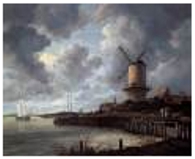Heather and I have just returned from ten wonderful days in The Netherlands. We began our trip by attending a three day Global Speaker’s Summit in the quaint village of Noordwijk on the shores of the North Sea (about 45 minutes from Amsterdam.) The conference brought together speakers, trainers, consultants, and facilitators from across Europe and around the world to share experiences and perspectives. It was a great time to renew friendships, make new ones, learn about new approaches, technologies, and trends, and share experiences.
 Following the conference, Heather and I went to Amsterdam for a week’s vacation. The unseasonably warm and sunny weather showcased an enthralling city. We had no idea how much water was in and around Amsterdam. Now it’s very clear why it’s called “the Venice of the north!” We took in as many bus tours, canal boat rides, and walks as we could fit into the week.
Following the conference, Heather and I went to Amsterdam for a week’s vacation. The unseasonably warm and sunny weather showcased an enthralling city. We had no idea how much water was in and around Amsterdam. Now it’s very clear why it’s called “the Venice of the north!” We took in as many bus tours, canal boat rides, and walks as we could fit into the week.
As an avid history buff, I was especially fascinated by The Dutch Golden Age. This period covered most of the 1600s. It was a booming time when The Netherlands rapidly became the most dominant and wealthiest nation on earth. An early “industrial revolution” powered by wind (the country had 10,000 windmills at one point), peat (as they drained bogs and opened up new land), new agricultural techniques, the birth of the modern stock exchange, corporate finance (the Dutch East India Company was the world’s first multinational) and revolutionary shipbuilding technologies (such as the sawmill) propelled the Dutch economy to the highest standard of living in Europe.
All this prosperity led to a boom in building the city (the architecture of the tall and skinny buildings along the canals is very unique) and cultural activities – especially paintings. The Dutch Masters became a very large group of painters that were so prolific there were something like 1.5 million paintings produced during this period! The oversupply created many starving artists with incredible talent. I thoroughly enjoyed a day at the Rijksmuseum looking at paintings by Rembrandt and his contemporaries. If you’re interested in European art, a wonderful web site that enables virtual viewing of thousands of paintings is the Web Gallery of Art. Go to http://www.wga.hu/index1.html for a tour of the Low Countries art and then wander around from there. I’ve spent hours lost in the many galleries and time periods there.
 Like a flower garden, The Dutch Golden Age rapidly blossomed to vibrant life and then quickly faded away. A combination of economic, military, technological, and political factors brought about the country’s rapid decline in the early 1700s. The underlying theme was failing to adapt to a changing world.
Like a flower garden, The Dutch Golden Age rapidly blossomed to vibrant life and then quickly faded away. A combination of economic, military, technological, and political factors brought about the country’s rapid decline in the early 1700s. The underlying theme was failing to adapt to a changing world.
History teaches us time and time again: today’s success carries with it the seeds for tomorrow’s failure. Unless we’re constantly pulling out those weed seeds and renewing our growth we can fall straight into the classic “failure of success” trap.
For over 30 years, Jim Clemmer’s practical leadership approaches have been inspiring action and achieving results. He has delivered thousands of keynote presentations, workshops, and management team retreats to hundreds of organizations around the globe moving his audiences from inspiration to application. He’s listed in the World’s Top 30 Most Influential Leadership Gurus based on research with 22,000 global business people, consultants, academics and MBAs. His website is www.JimClemmer.com.

Be the first to comment on "Jim Clemmer: Change Lessons from History"